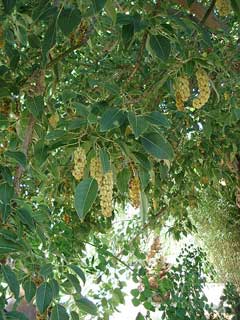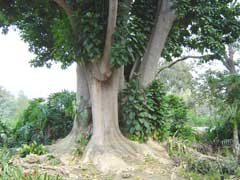 |
|
http://commons.wikimedia.org/wiki/User:RuB |
 |
| http://en.wikipedia.org/wiki/User:Geographer |
Translate this page:
Summary
Physical Characteristics

 Phytolacca dioica is an evergreen Tree growing to 4 m (13ft 1in).
Phytolacca dioica is an evergreen Tree growing to 4 m (13ft 1in).
See above for USDA hardiness. It is hardy to UK zone 9 and is frost tender. It is in leaf all year. The species is hermaphrodite (has both male and female organs).
Suitable for: light (sandy), medium (loamy) and heavy (clay) soils. Suitable pH: mildly acid, neutral and basic (mildly alkaline) soils. It can grow in semi-shade (light woodland) or no shade. It prefers moist soil.
UK Hardiness Map
US Hardiness Map
Synonyms
Plant Habitats
Woodland Garden Sunny Edge; Dappled Shade;
Edible Uses
Edible Parts: Fruit Leaves Shoots
Edible Uses: Colouring
Young leaves and shoots - cooked and used as a vegetable[183]. The leaves should not be eaten raw and only the young leaves should be used since they become toxic with age. The fruits are made into jellies or jams and are also used as a red colouring for food[183]. Some caution is advised. See notes on toxicity.
References More on Edible Uses
Medicinal Uses
Plants For A Future can not take any responsibility for any adverse effects from the use of plants. Always seek advice from a professional before using a plant medicinally.
None known
References More on Medicinal Uses
The Bookshop: Edible Plant Books
Our Latest books on Perennial Plants For Food Forests and Permaculture Gardens in paperback or digital formats.

Edible Tropical Plants
Food Forest Plants for Hotter Conditions: 250+ Plants For Tropical Food Forests & Permaculture Gardens.
More

Edible Temperate Plants
Plants for Your Food Forest: 500 Plants for Temperate Food Forests & Permaculture Gardens.
More

More Books
PFAF have eight books available in paperback and digital formats. Browse the shop for more information.
Shop Now
Other Uses
A red ink is obtained from the fruit.
Special Uses
References More on Other Uses
Cultivation details
An easily grown plant, succeeding in most soils[1], though preferring a moisture retentive fertile soil in full sun or partial shade[200]. Plants can be grown in quite coarse grass, which can be cut annually in the autumn[233]. This species is not hardy in the colder areas of the country, it tolerates temperatures down to between -5 and -10°c[200]. A spreading shade-giving tree in its native habitat, it might develop as a shrub in a warm sheltered position in Britain[200]. The young growth in spring can be damaged by late frosts. Plants seem to be immune to the predations of rabbits[233].
References Carbon Farming Information and Carbon Sequestration Information
Temperature Converter
Type a value in the Celsius field to convert the value to Fahrenheit:
Fahrenheit:
The PFAF Bookshop
Plants For A Future have a number of books available in paperback and digital form. Book titles include Edible Plants, Edible Perennials, Edible Trees,Edible Shrubs, Woodland Gardening, and Temperate Food Forest Plants. Our new book is Food Forest Plants For Hotter Conditions (Tropical and Sub-Tropical).
Shop Now
Plant Propagation
Seed - sow autumn or spring in a cold frame[200]. When they are large enough to handle, prick the seedlings out into individual pots and grow them on in the greenhouse for their first winter. Plant them out into their permanent positions in late spring or early summer, after the last expected frosts. If you have sufficient seed, it might be worthwhile trying an outdoor sowing in a seed bed in early spring. Grow the plants on in the seedbed for their first year and plant them out the following spring. Division in March or October. Use a sharp spade or knife to divide the rootstock, making sure that each section has at least one growth bud. Very easy, larger divisions can be planted out direct into their permanent positions. We have found that it is better to pot up the smaller divisions and grow them on in light shade in a cold frame until they are well established before planting them out in late spring or early summer.
Other Names
If available other names are mentioned here
Native Range
SOUTHERN AMERICA: Brazil, Bolivia, Ecuador, Peru, Argentina, Paraguay, Uruguay
Weed Potential
Right plant wrong place. We are currently updating this section.
Please note that a plant may be invasive in one area but may not in your area so it's worth checking.
Conservation Status
IUCN Red List of Threatened Plants Status :

Growth: S = slow M = medium F = fast. Soil: L = light (sandy) M = medium H = heavy (clay). pH: A = acid N = neutral B = basic (alkaline). Shade: F = full shade S = semi-shade N = no shade. Moisture: D = dry M = Moist We = wet Wa = water.
Now available:
Food Forest Plants for Mediterranean Conditions
350+ Perennial Plants For Mediterranean and Drier Food Forests and Permaculture Gardens.
[Paperback and eBook]
This is the third in Plants For A Future's series of plant guides for food forests tailored to
specific climate zones. Following volumes on temperate and tropical ecosystems, this book focuses
on species suited to Mediterranean conditions—regions with hot, dry summers and cool, wet winters,
often facing the added challenge of climate change.
Read More
Expert comment
Author
(L.)Moq.
Botanical References
200
Links / References
For a list of references used on this page please go here
Readers comment